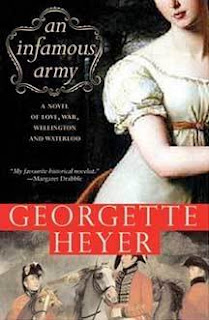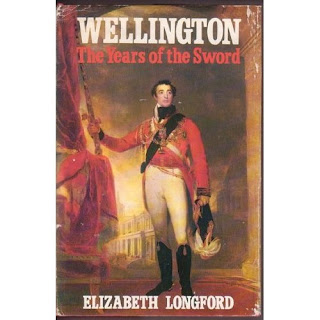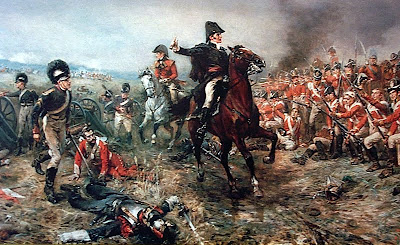The Battle of Waterloo: The Video – Part Two
Though the rain continued to pour down and a Frenchman on a loudspeaker insisted on narrating the entire bloody Battle (and although people persisted in standing up in front of me and blocking the view), I remained in position on the confounded Mound and stayed to finish filming the action. Actually, it was at about this point that my daughter left me to the elements and hightailed it down to the nearby pub. However, in my guise as your intrepid reporter, I manned my post, aimed my camera . . . and this is what I saw:
The Battle of Waterloo: The Video – Part One
Exploring the Battlefields at Waterloo
After he reached Paris, Napoleon’s plan was to march north from the French border to Brussels, defeating the Allied troops stationed around Brussels led by Wellington and the Prussian troops who were moving west from Germany toward a rendezvous with Wellington. Napoleon planned to prevent that meeting by keeping the two Allied armies apart. The plan of Wellington and Blücher was to meet up and defeat the French forces. At right, Prussian Field Marshall Gebhard Leberecht von Blücher.
The first battle was Quatre Bras (pronounced something like Ka-tra-BRA, meaning Four Arms), a strategic crossroads village. The road from the French border north to Brussels here crosses the east-west road from Germany to the coastal ports. At left, Quatre Bras today.
The English arrived here on the morning of June 16 and met French forces sent by Napoleon and led by Marshal Ney. As more and more Allied troops arrived, Wellington was able to hold off the French.
 Above, the monument at Fleurus honors three French victories. The 1815 victory at the nearby village of Ligny over the Prussians was the final victory of Napoleon’s career on June 16, 1815. Two days later, so to speak, he met his Waterloo!
Above, the monument at Fleurus honors three French victories. The 1815 victory at the nearby village of Ligny over the Prussians was the final victory of Napoleon’s career on June 16, 1815. Two days later, so to speak, he met his Waterloo!to fight the French with their combined forces.
about Wellington’s victory over Napoleon. Must have been translated from the French!
 Here are a couple of suggestions for further reading on the Battle of Waterloo. If you are a fiction fan, the account in Georgette Heyer’s novel An Infamous Army was once used as a text at the British military college Sandhurst.
Here are a couple of suggestions for further reading on the Battle of Waterloo. If you are a fiction fan, the account in Georgette Heyer’s novel An Infamous Army was once used as a text at the British military college Sandhurst. The final Sharpe adventure is excellent, and the account of the battle is reasonably accurate if you remove Sharpe from the action, in a sense.
The final Sharpe adventure is excellent, and the account of the battle is reasonably accurate if you remove Sharpe from the action, in a sense. The late Elizabeth Longford wrote a two-volume biography of the Duke of Wellington. In the first of these, The Years of the Sword, there is an excellent account of the battle.
The late Elizabeth Longford wrote a two-volume biography of the Duke of Wellington. In the first of these, The Years of the Sword, there is an excellent account of the battle. Of course there are hundreds of books about the Battle of Waterloo, the Peninsular Wars, the Napoleonic Wars, the Congress of Vienna, etc. etc. as well as websites, blogs and films. I haven’t fnished it yet, but I also recommend the book by the expert who accompanied our Waterloo visit, Jeremy Black of the Univerity of Exeter, UK.
Of course there are hundreds of books about the Battle of Waterloo, the Peninsular Wars, the Napoleonic Wars, the Congress of Vienna, etc. etc. as well as websites, blogs and films. I haven’t fnished it yet, but I also recommend the book by the expert who accompanied our Waterloo visit, Jeremy Black of the Univerity of Exeter, UK.And The Collection Continues To Grow . . . .
In a previous post, I told you about my latest Duke of Wellington aquisition, found in Cecil Court, London. I’m happy to say that the Duke has arrived home from being framed and is now in his new place of honour on my wall.
The hand-coloured engraving is after an 1821 painting by Sir Thomas Lawrence and I had it museum mounted, double matted and placed under conservation glass. It is, if I do say so, a magnificent piece. When I arrived home with Arthur, my husband decided to help me hang the portrait. The conversation went something like this:
“Where’s my stud finder?”
“What for?”
“To find the stud. So we can hang the picture.”
“It weighs less than 20 pounds. We don’t need to find a stud. Instead we need to measure the distance between the end of the dresser and the wall and hang it at the midway point. So it’s centered in that space.”
Grumble. Grumble.
“Where do you want the nail? Here?”
“Pictures should be hung at eye level. I suppose that’s eye level if you’re Wilt Chamberlain.”
“Alright then. Whose eye level? Yours or mine?”
“Split the difference.”
Grumble. Grumble.
“Oh, it looks perfect. Just perfect!”
“Hhhnnn.”
“Look at it! Isn’t it wonderful?”
“It’s the Duke of Wellington. Again. Don’t ask me to get excited over it. If you like it, that’s all that matters.”
“You could show some enthusiasm.”
“What do you want me to do, drool over it?”
“No. But can’t you muster some Victoria-like enthusiasm?”
“You should have married Victoria.”
“I’m not asking you to be Victoria 24/7. Just for about 30 seconds during the official hanging ceremony.”
“Ain’t gonna do it.”
Things went alot smoother when I framed, matted and hung the three fashion pirnts I’d bought in Paris. They went smoother because I did it all last week, when my husband was in Pennsylvania for a few days. They were hung with no fuss, no muss and no stud finder (men!).
I told Victoria that the style of drawing led me to think they’d been done in the 1930’s or 40’s, but while doing some reseasrch on the web, I found that these drypoint etchings were done by Henri Boutet in 1902 for a book called “Les Modes Feminines du XIXe Siecle.” His 100 etchings traced fashions for each year from 1801 to 1900. Boutet used a drypoint etching technique that produces an intrinsic softness of texture. The illustrations were closely detailed and hand-coloured and the original etchings were limited to 600 copies. I did find prints from the same book, though not those I bought, selling online for $75 each. I paid 40 euros, or $52, for all three together. Nothing for my husband to grumble about there. I have my portrait of the second Duchess of Wellington out at the framer’s now. While the engraving is not new, I never liked the way it had been framed and so decided to give her a facelift, so to speak. I’ll let you know when the Duchess is at home.




